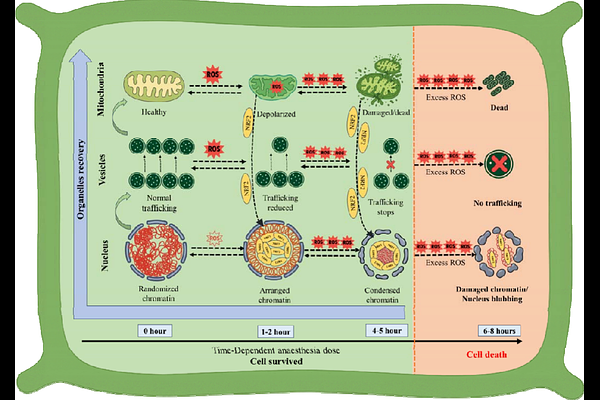A Hierarchical Cascade of Organellar Silencing and their Regeneration under Anaesthetic Stress in Plants

A Hierarchical Cascade of Organellar Silencing and their Regeneration under Anaesthetic Stress in Plants
Chandra, S.; Chouhan, S.; Mukherjee, B.; Salam, A.; Behera, L.; Nandi, C. K.
AbstractAnaesthetics are pharmacological drugs that temporarily inhibit neural activity by acting on voltage-gated sodium channels and GABA receptors. Although their neurological mechanisms are well-defined, their wider cellular effects, especially in non-neuronal systems, are inadequately understood d. This study utilized Solanum lycopersicum plants root apex cells as a transparent model to examine anaesthetic-induced subcellular alterations via live-cell fluorescence imaging, immunostaining, and super-resolution microscopy. Our findings, first of its kind, demonstrate the initial comprehensive model of sequential causal structure and hierarchical cascade of organelle collapse of different but important organelles such as mitochondria, lysosome, vesicles trafficking and nuclear architectures under anaesthesia in plants. The nucleus is identified as the most important controller of recovery potential and cellular fate. In a time dependent experiment, we found that plant cells exposed to lidocaine for up to four hours could still recover mitochondrial potential, lysosomal function, and nuclear integrity when anaesthesia is removed. However, beyond four hours, the damage, especially to the nucleus, was irreversible, and cells proceeded to programmed cell death. Our data further demonstrate that organelle functions can recover after brief exposure to anaesthetic stress. However, prolonged exposure prevents recovery, resulting in the irreversible degradation of the nucleus leading to complete cell death. The results present novel targets for preventative therapies, such as mitochondrial antioxidants, lysosomal stabilizers, and nuclear structural protectants that could mitigate anaesthetic-induced damage.